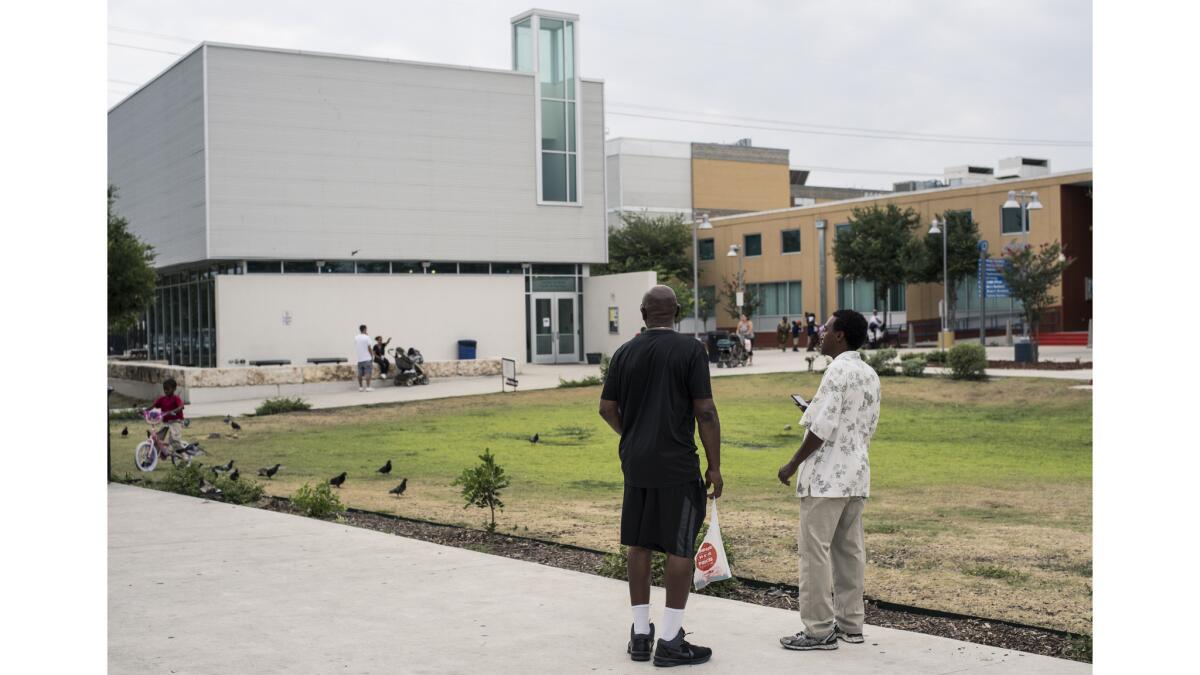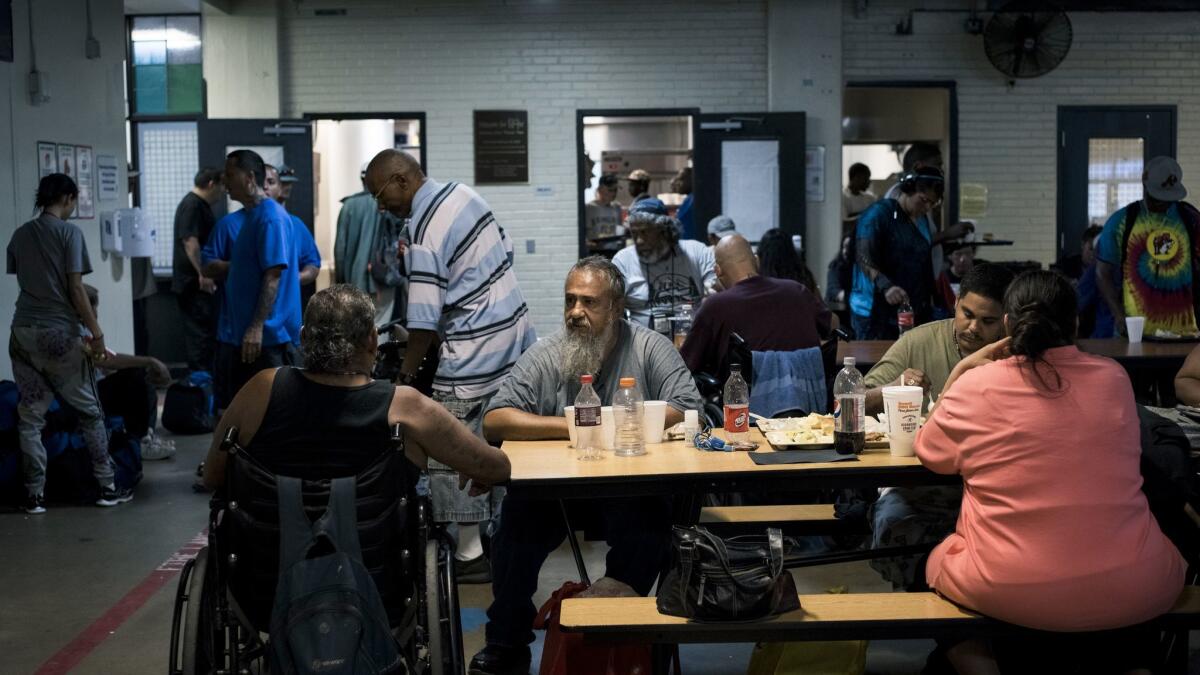Here’s how a Texas oilman’s vision spawned a homeless shelter extraordinaire

It used to be that Ron Brown would work the storefronts of downtown San Antonio, trying to persuade homeless people to leave the city streets for a shelter.
Now the outreach worker’s daily missions take him more often to freeway overpasses and wooded areas outside town because the downtown homeless count has plummeted, from nearly 800 in 2010 to just over 100 last year.
The change reflects an unusual effort to deal with the homeless population in the city famous for the Alamo and the River Walk.
Guided by a retired oil and gas executive who has put millions of dollars into a personal vision, San Antonio has departed from the prevailing thinking of today’s homeless services establishment.
While federal policymakers and providers across the country espouse the “housing first” philosophy that strives to move people through shelters into permanent housing quickly, San Antonio has embraced a traditional model of extended shelter while encouraging personal transformation.
The vision is that of William E. Greehey, former chief executive of San Antonio-based refining giant Valero. In retirement, Greehey yearned for a cause.
He and his wife “could not figure out what I wanted to do that would make a difference,” Greehey said. “We prayed about it.”
His prayer was answered by a local television report on homelessness.
“What I saw was that all we were doing was recycling the homeless people that would go to jail, come out of jail, get sick, go to the emergency room, get treated, get back on the street. We weren’t doing anything to address the root cause of why these people were homeless,” he said.
For the next five years, Greehey lobbied San Antonio officials and cajoled other wealthy Texans. In 2010 his efforts culminated in the $101-million Haven for Hope, a Texas-sized shelter.

Covering 23 acres, it most resembles a junior college campus. Haven has dormitories for 850, detox and psychiatric observation units, a sobering center and medical and dental clinics. Even a YMCA. There’s a free-standing chapel, serving the program’s faith orientation, and a for-profit call center staffed by shelter residents or, as they’re called, “members.”
At a more typical shelter, those services might have to be brought in or residents shuttled to them by bus. At Haven, everything is a short walk away. At the center of campus, smartly designed buildings encircle a grassy quad. Children play soccer there after returning from school. Adults stroll or relax on park benches between appointments for case management, training, psychotherapy and healthcare.
More than 60 nonprofit partners are on campus, including St. Vincent de Paul, which feeds the campus, and Street2Feet, a jogging club. Staff members, distinguishable only by their ID cards, intermingle on the grounds, greeting residents by name with palpable affection.
That's the Haven for Hope that stands out on promotional materials.
There’s also an uncomfortable counterpoint. It’s the Courtyard, an expansive slab of concrete where those who are not ready for “transformation” sleep. Every night up to 750 people crowd into an open-air space that was designed for 400. They eat in a large hall, collect their mattresses and find a spot on the concrete.
The Courtyard was a concession to members of the City Council who wanted a spartan facility that would help motivate the homeless to enter Haven for Hope, which is more attractive but also demands more of residents.

“When I started working with the city on this, the city was not as interested in transformation as they were in finding a place for these people to go to get them off the street,” Greehey said. “So that’s how we settled with two campuses.”
The Courtyard has achieved some of the results its backers hoped for. More than 5,500 former Courtyard residents have moved onto the transformational campus, says Scott Ackerson, Haven’s former vice president for strategic relationships. For hundreds more it provides an alternative to the dangers of the downtown streets and the attention of law enforcement.
Police Chief William McManus once had a hard-nosed policy on the homeless. He now concedes it did little but bring him chagrin.
The frequent arrests under his watch came under fire when local reporters found a homeless man who had received more than 1,000 citations. Then McManus met ridicule when he proposed an ordinance making it a misdemeanor to give money to panhandlers.
“You can’t arrest yourself out of this problem," McManus said, acknowledging his error.
In 2015 he joined Melody Woosley, director of the city’s Department of Human Services, in committing to a new approach to connect homeless people with services.
Today, two officers on a HOPE (Homeless Outreach Positive Encounters) detail work full time on the homeless beat, acting almost like extensions of Haven. When they find somebody drunk in “Zombie Park,” instead of arresting him for public inebriation, they drop him at Haven’s sobering center.
Unlike most homeless facilities, Haven for Hope was built without any federal dollars and runs with almost none. Nearly 60% of construction funding came from private contributions rounded up by Greehey. The city of San Antonio purchased the land for $22.5 million.
Half of its $16-million annual budget comes from private sources, $1 million directly from Greehey and $3 million from a golf tournament he puts on. Only 3% is from the federal government, a fraction of what most shelters receive.
Executive Director Kenny Wilson said he would like to increase Haven’s federal support, but not by sacrificing its transformational mission. Haven’s model requires members to be drug- and alcohol-free and to commit to turning their lives around. It allows them up to two years to do so.
In contrast, sobriety is not required under the housing-first policy used by many shelters. Their services are aimed at getting people into permanent housing as quickly as possible, not at turning their lives around.
Referring to requirements placed on funding from the U.S. Department of Housing and Urban Development, Wilson said, “We don’t want to be limited by HUD funding to where all we can do is housing first. We do more than that.”

Wilson underscores the point with a thank-you letter from a graduate.
“I’ve changed in the time I’ve been here,” the former drug addict wrote. “Transformation begins in the heart. If we don’t let go we can never change.”
Among Haven’s staff, housing first doesn’t hold the unqualified loyalty that many homeless advocates now give it.
Ackerson, who recently left Haven to join Health Management Associates Inc., says that approach can fail to address a central need of homeless people — community. He described housing-first philosophy as, “We’ll put you in an apartment somewhere; it doesn’t matter where, but we got you housed.” But a lack of community, he said, leads to social isolation.
Though Haven’s model allows members to stay up to two years, the average stay is about six months.
True to Haven’s visionary culture, founder Greehey and chief executive Wilson measure success in personal stories.
Greehey speaks of a man he first met under a bridge who refused all offers of help.
Later, they met on campus. “Mr. Greehey, remember me?” the man said. “I’ve been sober for three months. I’ve reunited with my family. Now I’m going to get a bakery.”
Statistics give a nuanced view of Haven’s effectiveness.
In seven graduating classes, nearly 3,500 people have progressed from the transitional campus into permanent housing, and 90% retained their homes for at least a year, according to Haven’s records.
The sobering facility built by Haven and run by the Center for Health Care services has been credited with saving $2 million annually by keeping homeless people out of jail and police officers out of court.
Those positives are tempered by a report drawn from Haven’s records at the request of The Times. During 2015 and 2016, about 40% of campus members progressed to permanent housing, slightly better than the 30% goal in typical shelter contracts.
Still, that means 60% left without housing. About 24% were unaccounted for and others moved on to other shelters, treatment programs or jail.

Haven’s reputation has attracted interest from around the country. Delegations from 250 cities have come looking for ideas to take home. But no other city has attempted to build something like it.
The Los Angeles County city of Pomona sent a delegation. Following Haven’s example, officials there decided to build a services-rich shelter on a much smaller scale. But they rejected the idea of an open-air sleeping space.
The very characteristics that make Haven intriguing also make it unlikely it will ever be replicated:
A wealthy benefactor, a motivated city, a vision and the will to cut across the grain.
ALSO
Denver finds a simple and innovative way to help the homeless — wash their clothes
In Portland, a fitful start to a new way to help the homeless: A village of tiny houses
One size doesn't fit all: In Salt Lake City, a community rethinks how it helps its homeless
Sign up for Essential California
The most important California stories and recommendations in your inbox every morning.
You may occasionally receive promotional content from the Los Angeles Times.








